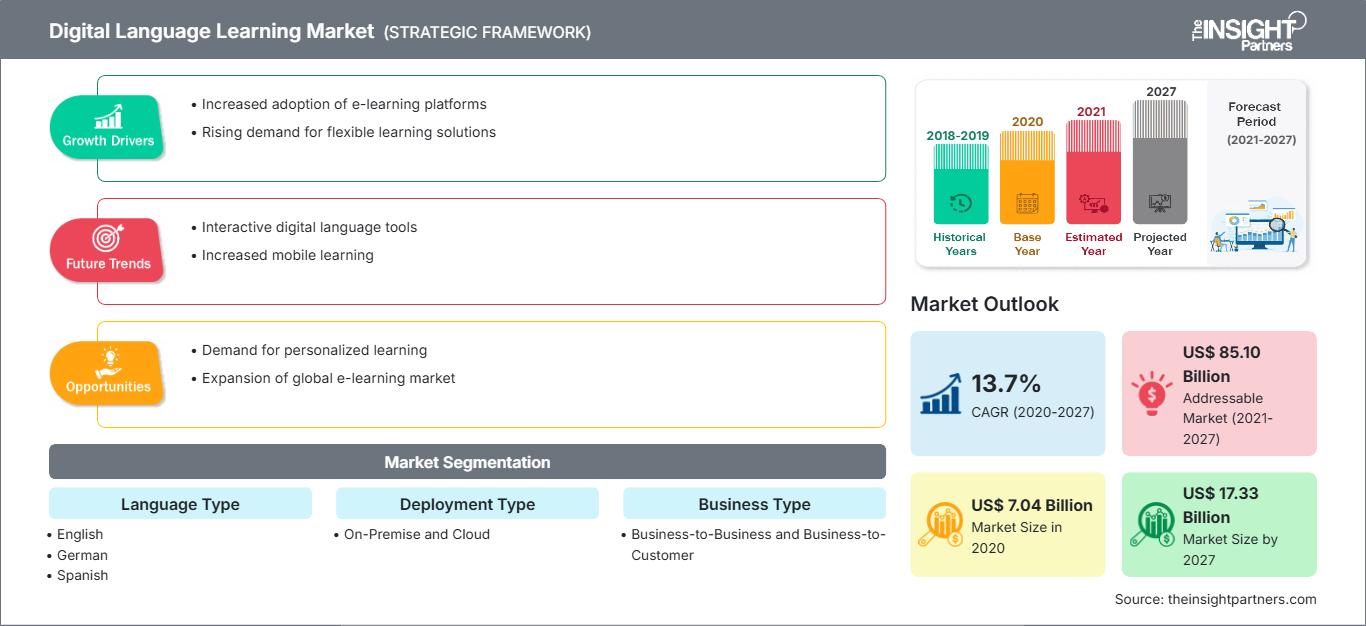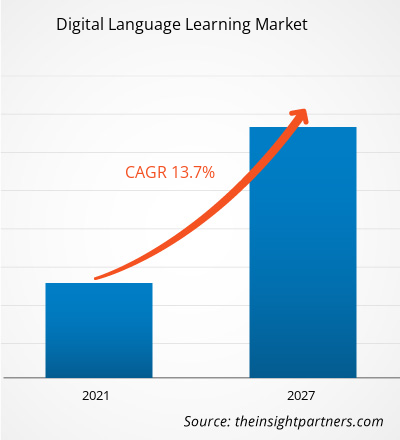Se espera que el mercado de aprendizaje de idiomas digitales crezca de US$ 7038,2 millones en 2020 a US$ 17333,4 millones en 2027; se estima que crecerá a una CAGR del 13,7% entre 2020 y 2027.
Las iniciativas de diversos gobiernos para implementar programas de aprendizaje del inglés contribuyen al crecimiento del mercado. El sector educativo global se está transformando exponencialmente gracias a diversas iniciativas gubernamentales y privadas para mejorar el rendimiento digital. Gobiernos de países como China, Australia, Brasil y Emiratos Árabes Unidos han puesto en marcha programas de educación digital en los últimos años, lo que ha ayudado a estos países a impulsar sus sistemas de educación en inglés. Por ejemplo, la Revolución de la Educación Digital (DER) del gobierno australiano, iniciada hace una década, ha permitido que varias escuelas y universidades aprovechen la educación digital. De igual manera, el gobierno chino también ha puesto en marcha diversas políticas para impulsar la educación digital, con un enfoque principal en el aprendizaje del inglés, lo que ha impulsado el aumento del número de empresas que ofrecen soluciones de aprendizaje digital a estudiantes chinos. 51Talk es una de las instituciones de aprendizaje digital de inglés más destacadas de China; 17Zuoye es otra plataforma digital para estudiantes, profesores y padres chinos, que ofrece tareas en línea en forma de ejercicios y tareas, lo que permite a los usuarios finales mejorar sus capacidades. Actualmente, India se está esforzando por crear un mercado sustancial para la educación digital. El gobierno indio ha emprendido diversas iniciativas para popularizar las tecnologías de digitalización en el sector educativo. SWAYAM es la plataforma de aprendizaje digital más destacada del gobierno indio, que ayuda a los estudiantes a optar por cursos en línea que abarcan todas las áreas de la educación superior. Las universidades internacionales también pueden ofrecer sus respectivos cursos y exámenes a través de la plataforma SWAYAM, lo que facilita a los estudiantes aprender y optar por exámenes de universidades internacionales. Esto mejora las habilidades de aprendizaje, expresión oral y escritura del inglés. La Biblioteca Digital Nacional es otra iniciativa implementada por el gobierno indio con la visión de ofrecer una fuente virtual de recursos de aprendizaje desde una única plataforma. Esta iniciativa está ganando prominencia gradualmente y se espera que impulse el crecimiento del mercado del aprendizaje digital del inglés en India en los próximos años, contribuyendo así al crecimiento del mercado global del aprendizaje digital de idiomas.
Recibirá personalización de cualquier informe, sin cargo, incluidas partes de este informe o análisis a nivel de país, paquete de datos de Excel, y además aprovechará grandes ofertas y descuentos para empresas emergentes y universidades.
Mercado del aprendizaje digital de idiomas: perspectivas estratégicas

-
Obtenga las principales tendencias clave del mercado de este informe.Esta muestra GRATUITA incluirá análisis de datos, desde tendencias del mercado hasta estimaciones y pronósticos.
Impacto de la pandemia de COVID-19 en el mercado del aprendizaje digital de idiomas
El reciente brote de la pandemia ha generado una considerable disrupción positiva en el sector educativo global durante los últimos meses. Además, la disrupción en las instituciones educativas convencionales y las técnicas de aprendizaje presencial ha provocado un aumento en la adopción de soluciones de aprendizaje en línea y digitales robustas y eficientes, y se prevé que continúe impulsando el crecimiento del mercado más allá de la pandemia en los próximos años. Por ejemplo, la UNESCO, junto con varios representantes destacados de empresas tecnológicas y la UIT (Unión Internacional de Telecomunicaciones), colaboraron para destacar la importancia económica de la adopción de tecnologías digitales en el aprendizaje, con el fin de facilitar capacidades de aprendizaje rápido entre un público más amplio sin una inversión considerable en infraestructura física en las economías emergentes. Por otro lado, en una encuesta independiente realizada por la Universidad de Cambridge, más de 1200 encuestados identificaron una mayor propensión a continuar con las tecnologías de aprendizaje digital entre el 60 % de los candidatos encuestados en los próximos años. Por lo tanto, el reciente brote ha facilitado un aumento en la adopción de tecnologías de aprendizaje digital y, posteriormente, ha tenido un impacto positivo en el crecimiento del mercado en los últimos meses.
Perspectivas del mercado: mercado del aprendizaje digital de idiomas
Aprovechar tecnologías avanzadas y simplificadas para atraer a los estudiantes hacia la educación digital
En países desarrollados, como Estados Unidos y el Reino Unido, el sistema de educación digital ha ganado una inmensa popularidad, ya que los estudiantes de escuelas, universidades y otras instituciones están completamente familiarizados con las tecnologías. Sin embargo, en los países de Asia Pacífico y el Sur de Asia, los estudiantes carecen de la conciencia del aprendizaje impulsado por la tecnología. Varias escuelas, universidades e instituciones de formación están implementando tecnologías digitales en sus clases. Mientras los desarrolladores de plataformas educativas digitales actualizan constantemente sus tecnologías para ofrecer soluciones robustas, quienes las adoptan en Asia Pacífico también actualizan continuamente su infraestructura tecnológica. Se espera que las innovadoras aplicaciones educativas, sitios web y otros servicios basados en la nube creen un mercado significativo para la educación digital, incluyendo soluciones digitales para el aprendizaje de idiomas.
Perspectivas basadas en tipos de lenguaje
Según el tipo de idioma, el mercado del aprendizaje digital de idiomas se segmenta en inglés, mandarín, español, alemán y otros. El segmento de inglés tuvo la mayor cuota de mercado en 2019.
Perspectivas regionales del mercado del aprendizaje digital de idiomas
Los analistas de The Insight Partners han explicado detalladamente las tendencias y los factores regionales que influyen en el mercado del aprendizaje digital de idiomas durante el período de pronóstico. Esta sección también analiza los segmentos y la geografía del mercado del aprendizaje digital de idiomas en Norteamérica, Europa, Asia Pacífico, Oriente Medio y África, y Sudamérica y Centroamérica.
Alcance del informe del mercado de aprendizaje digital de idiomas
| Atributo del informe | Detalles |
|---|---|
| Tamaño del mercado en 2020 | US$ 7.04 mil millones |
| Tamaño del mercado en 2027 | US$ 17.33 mil millones |
| CAGR global (2020-2027) | 13,7% |
| Datos históricos | 2018-2019 |
| Período de pronóstico | 2021-2027 |
| Segmentos cubiertos |
Por tipo de idioma
|
| Regiones y países cubiertos |
América del norte
|
| Líderes del mercado y perfiles de empresas clave |
|
Densidad de actores del mercado del aprendizaje digital de idiomas: comprensión de su impacto en la dinámica empresarial
El mercado del aprendizaje digital de idiomas está creciendo rápidamente, impulsado por la creciente demanda de los usuarios finales debido a factores como la evolución de las preferencias de los consumidores, los avances tecnológicos y una mayor conciencia de los beneficios del producto. A medida que aumenta la demanda, las empresas amplían su oferta, innovan para satisfacer las necesidades de los consumidores y aprovechan las tendencias emergentes, lo que impulsa aún más el crecimiento del mercado.

- Obtenga una descripción general de los principales actores clave del mercado de aprendizaje de idiomas digitales
Los actores que operan en el mercado del aprendizaje de idiomas digitales se centran principalmente en el desarrollo de productos avanzados y eficientes.
- En 2019, Fluenz anunció la expansión de su Programa de Inmersión de Lujo en Español a Barcelona, España, en la primavera de 2020. Los usuarios podrían unirse al programa durante seis días para aprender idiomas.
- En 2018, Preply, Inc. anunció sus planes de abrir una nueva oficina en Barcelona a principios de 2019. La expansión fue resultado de una financiación de 4 millones de dólares en julio. La compañía también planea expandir su presencia en los mercados alemán, británico, estadounidense y latinoamericano.
El mercado de aprendizaje de idiomas digitales se ha segmentado de la siguiente manera:
Mercado global de aprendizaje digital de idiomas: por tipo de idioma
- Inglés
- Alemán
- Español
- mandarín
- Otros
Mercado global de aprendizaje digital de idiomas: por tipo de implementación
- Local
- Nube
Mercado global de aprendizaje digital de idiomas: por tipo de negocio
- De empresa a empresa
- De empresa a cliente
Mercado global de aprendizaje digital de idiomas: por usuario final
- Académico
- No académico
Mercado global de aprendizaje digital de idiomas: por geografía
-
América del norte
- A NOSOTROS
- Canadá
- México
-
Europa
- Francia
- Alemania
- Italia
- Rusia
- Reino Unido
- Resto de Europa
-
Asia Pacífico (APAC)
- Japón
- Porcelana
- Australia
- India
- Corea del Sur
- Resto de APAC
-
Oriente Medio y África (MEA)
- Arabia Saudita
- Emiratos Árabes Unidos
- Sudáfrica
- Resto de MEA
-
América del Sur (SAM)
- Brasil
- Argentina
- Resto de SAM
Mercado del aprendizaje digital de idiomas: perfiles de empresas
- Babbel
- Busuu, Ltd.
- Fluenz
- Lingoda GmbH
- Lenguaje vivo (Penguin Random House, LLC)
- Pearson PLC
- Preply, Inc.
- Rosetta Stone, Inc.
- Verbling, Inc.
- Yabla, Inc.
- Análisis histórico (2 años), año base, pronóstico (7 años) con CAGR
- Análisis PEST y FODA
- Tamaño del mercado, valor/volumen: global, regional y nacional
- Industria y panorama competitivo
- Conjunto de datos de Excel
Informes recientes
Informes relacionados
Testimonios
Razón para comprar
- Toma de decisiones informada
- Comprensión de la dinámica del mercado
- Análisis competitivo
- Información sobre clientes
- Pronósticos del mercado
- Mitigación de riesgos
- Planificación estratégica
- Justificación de la inversión
- Identificación de mercados emergentes
- Mejora de las estrategias de marketing
- Impulso de la eficiencia operativa
- Alineación con las tendencias regulatorias






















 Obtenga una muestra gratuita para - Mercado de aprendizaje digital de idiomas
Obtenga una muestra gratuita para - Mercado de aprendizaje digital de idiomas